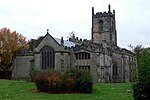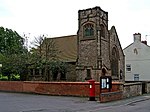Ashby de la Zouch Rural District
Districts of England abolished by the Local Government Act 1972Districts of England created by the Local Government Act 1894History of LeicestershireRural districts of EnglandUse British English from August 2012
Ashby de la Zouch Rural District was a rural district in England, near Ashby de la Zouch (which was an urban district). It was formed in 1894 along with most other rural districts. In 1974 it was abolished under the Local Government Act 1972, to form the non-metropolitan district of North West Leicestershire. The district originally consisted of three detached fragments. The larger part was between Ashby and Coalville. The parish of Blackfordby, west of Ashby, was split between the urban districts of Ashby de la Zouch and Ashby Woulds in 1936, whilst the parish of Bardon, east of Coalville, remained a detached portion.
Excerpt from the Wikipedia article Ashby de la Zouch Rural District (License: CC BY-SA 3.0, Authors).Ashby de la Zouch Rural District
Ashby Road, North West Leicestershire
Geographical coordinates (GPS) Address Nearby Places Show on map
Geographical coordinates (GPS)
| Latitude | Longitude |
|---|---|
| N 52.74 ° | E -1.44 ° |
Address
Ashby Road
Ashby Road
LE67 8FF North West Leicestershire
England, United Kingdom
Open on Google Maps







